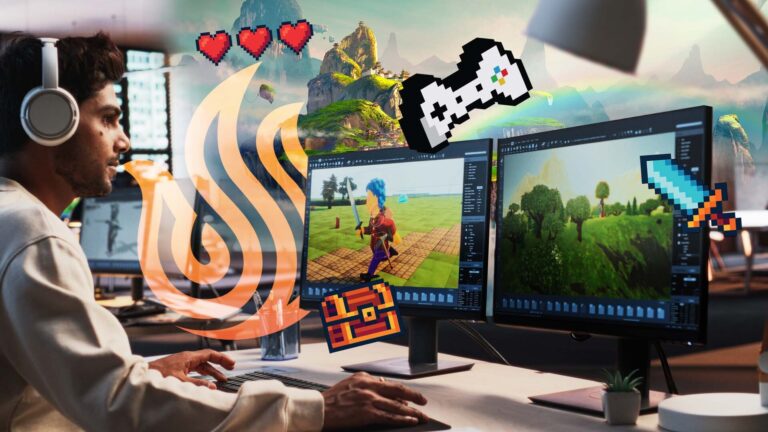As the computer industry continues to evolve at an exponential rate, tech enthusiasts are looking forward to the next big thing. Virtual Reality is one such experimental field that software companies have been flirting with for decades. However, the portrayal of lifelike virtual worlds in movies and television have consistently overshadowed the initial attempts by electronics manufacturers to bring VR to the masses.
The good news for tech enthusiasts is that the upcoming years pose a high probability of virtual reality finally hitting the mainstream. Modern VR headsets require less installation procedures and offer experiences that are closer than ever to what 80s and 90s pop culture predicted. This is resulting in people from all walks of life becoming believers in the inevitable virtual reality future.
What is Virtual Reality?
Virtual reality is the creation and application of a simulated world. This virtual world is separate from the one the user experiences on a daily basis. Despite being a completely fabricated realm, designers of virtual reality have the goal of making the world as believable as possible. It doesn’t have to be real per se, but it does need to make enough sense to trick the user’s mind into being immersed in the space before them.
While this may sound an awful lot like traditional video games, there is a key difference between true virtual reality experiences and those digital worlds that remain relegated to flat screens. VR experiences incorporate headsets, motion sensors, and wearable equipment to sell the idea that the person is actually participating in the activity at the location in question. The complexity of most VR setups often requires large spaces and may even take up full auditoriums in some commercial venues. Video game controllers may be used, but most VR companies have their own proprietary controllers that require motion to operate.
Who are the Major Players in the VR Space?
As VR is still a burgeoning industry with a fairly high barrier to entry, there are just a few big names who have been leading the charge in recent years. Here is a brief rundown of all the key companies vying for their piece of the virtual reality pie. In addition to these juggernauts, there are numerous startups in Silicon Valley and beyond testing out their own ideas for VR. Considering the untapped potential in the market, any company has the chance to stumble into the next big thing. However, the following tech giants already have the necessary funding and workforce that will ensure at least moderate success.
Oculus
Oculus was one of the pioneers of modern VR technology. They have developed numerous headsets over the years that have each shown potential. So much so that Facebook purchased them in 2014. Since then, the firm has been making great strides with VR integration into social media. From games to learning experiences, Oculus has managed to engage millions of tech enthusiasts in recent years.
HTC
The HTC Vive has been consistently near the top of many best VR headset lists since it launched. This is due to the fair price point and powerful performance offered. Most PC gamers intrigued by virtual reality gaming could modify one of the rooms in their home and start playing their existing Steam library in minutes. The popularity of the Vive assures HTC will have to develop the inevitable successor and propel themselves even closer to the top of the ladder.
It should come as no surprise that Google is experimenting with VR applications as well. The company needs no introductions and has become a household name due to developing products in just about every tech category imaginable. Since they already have so much attention on the mobile space, Google has worked on portable initiatives such as Google Cardboard, a VR headset that works with your phone. That being said, the corporation is large enough to branch out at any time.
Microsoft
Microsoft has worked on some virtual reality headsets in the past but have since moved closer to what they call “mixed reality” experiences. The name comes from the combination of virtual and augmented reality technology being combined into one device. Augmented reality is an offshoot of virtual reality that places digital data and visuals into the real world around you. The most popular example of this merging effect can be seen in Pokémon Go, which sees the titular creatures of that series imposed over the environment where your phone’s camera is pointed. Microsoft hopes to combine both virtual and augmented reality to create some truly memorable software.
Valve
Valve is the famous developer of games such as Half-Life and Counter-Strike that always pushed the limits of technology at the time of their release. After developing Steam, most PC gamers have come to know them as the premier digital storefront for titles new and old. To capitalize on the VR trend and continue the legacy of releasing cutting edge technology, Valve released the Index headset and a VR exclusive game called Half-Life Alyx. This newest installment in the beloved franchise has received critical acclaim and is considered the definite VR experience by many. For hardcore games, Valve is by far the most interesting company in the virtual reality race.
What is the Goal of Virtual Reality?
The scope of virtual reality is so expansive that it is most accurate to say that developers have multiple goals. Depending on the nature of a VR project, the design team may have some or even all of these goals. Here are the most commonly desired results of VR development.
Immersion
The whole reason someone wears a VR headset is to transport themselves to a simulated world that is even more engrossing than watching a movie or playing a game with surround sound. They want the fantasy in their heads of being a superhero or slaying a dragon to be fully realized through the simulation. VR developers know this and work diligently to ensure every aspect is as immersive as possible. While this does involve making things more realistic in some cases, the real magic is in making the simulation believable. A person’s mind knows there is no dragon in front of them if they think about it, but a good VR experience will keep them too wrapped up in the stimuli around them to consider anything but the scene they have been transported to.
Comfort
No matter how immersive the technical components of a VR showcase are, a person’s immersion will be shattered if they become uncomfortable. One of the main hurdles of VR is how headsets and other equipment affect the body during long sessions. Headsets that don’t fit properly can cause rashes and other skin conditions when strapped to the face for too long. Newer VR headsets are taking comfort into more account as a result of the disgruntled early adopters who shared their horror stories online. Motion controls and motion sickness also provide challenges for some users. As the technology evolves, you can expect more quality-of-life improvements that target comfort first and foremost.
New Gameplay Experiences
Gamers and VR go together like chocolate and peanut butter. There is already a ton of overlapping interest in both fields. The result is a bevy of games that are made exclusively for VR as well as existing games that get VR modes patched in after release. When these modes are done right, virtual reality can add many fun elements to games that simply wouldn’t translate over to traditional button controls. The added immersion augments many genres such as first-person shooters that already strive to give you the same perspective as the protagonist.
Education and Learning
There are also many educational opportunities opening up through the use of VR tech. Students can visit and even walk around digital recreations of historic places and events. Instead of just watching videos about Ancient Egypt, children could explore these spaces and learn at their own pace. Gaming can be added to these educational experiences but it isn’t required to provide students with a more enjoyable lesson.
Specialized Job Training
There are many jobs that require immense precision and accuracy. Occupations such as Surgeon are difficult to train for because of the delicate nature of the work. VR can be used to train people for these roles without putting anyone’s life in danger. As virtual reality becomes more accessible, it is poised to change the job market considerably.
Healing and Confronting Mental Trauma
One of the best ways to handle mental and emotional trauma is to confront it directly. Medical professionals have been using exposure therapy to help patients overcome their fears and even reduce symptoms of PTSD. By recreating the source of trauma in a safe virtual space, the patient can work through their issues by exploring them thoroughly. This goes to show just how far virtual reality can be taken outside the realm of games and entertainment.
Develop Something Completely New
Virtual Reality as we know it is still so new and exciting. Every day there are new developers conjuring up genius ideas. There is no telling what innovative ways VR will be used in the next decade. As an ode to this potential, this section is dedicated to all the brand-new concepts being dreamt up as you read this.
How Can I Get Started in Virtual Reality Development?
The best way to get started in VR is to attend a creative arts college with a dedicated 3D animation program. Learning to animate 3D objects and spaces is the first step to creating your own virtual worlds. These campuses provide state of the art technology that mimics what professional VR studios use. Considering the high cost of professional grade tech equipment, your best bet to gaining some experience with the necessary hardware is to attend a formal education program. Once enrolled, you can learn the right skills and establish a network of people who can help you land that first job at a VR firm.
Final Thoughts
Overall, anyone interested in VR development has a bright future ahead of them. The technology has come so far in just a few short years that the point of mass adoption is getting closer each day. As more and more people have their first positive VR experience, word of mouth will eventually spread. Becoming an established VR developer before that inevitable future is a great way to set yourself up for blazing success.
Do you have a few years to learn everything about virtual reality and 3D animation, to prepare for a job in the industry? If so, you can experience what it’s like being in the full animation and VFX pipeline in our Digital Art & Animation program. Our Digital Arts & Animation courses have been designed with input from industry connections, so University of Silicon Valley students learn the skills studios are looking for.
Start your animation career today and learn what it takes to become a 3D animator. The 3D Animation concentration delivers premium instruction by skilled industry mentors. You’ll master the fundamentals of animation, learn character rigging, and so much more.
University of Silicon Valley is uniquely poised to offer a meaningful and valuable education for 21st century students. We believe in an education that directly correlates with the work you’ll be doing after you graduate. Interested in learning more? Contact Us today.


